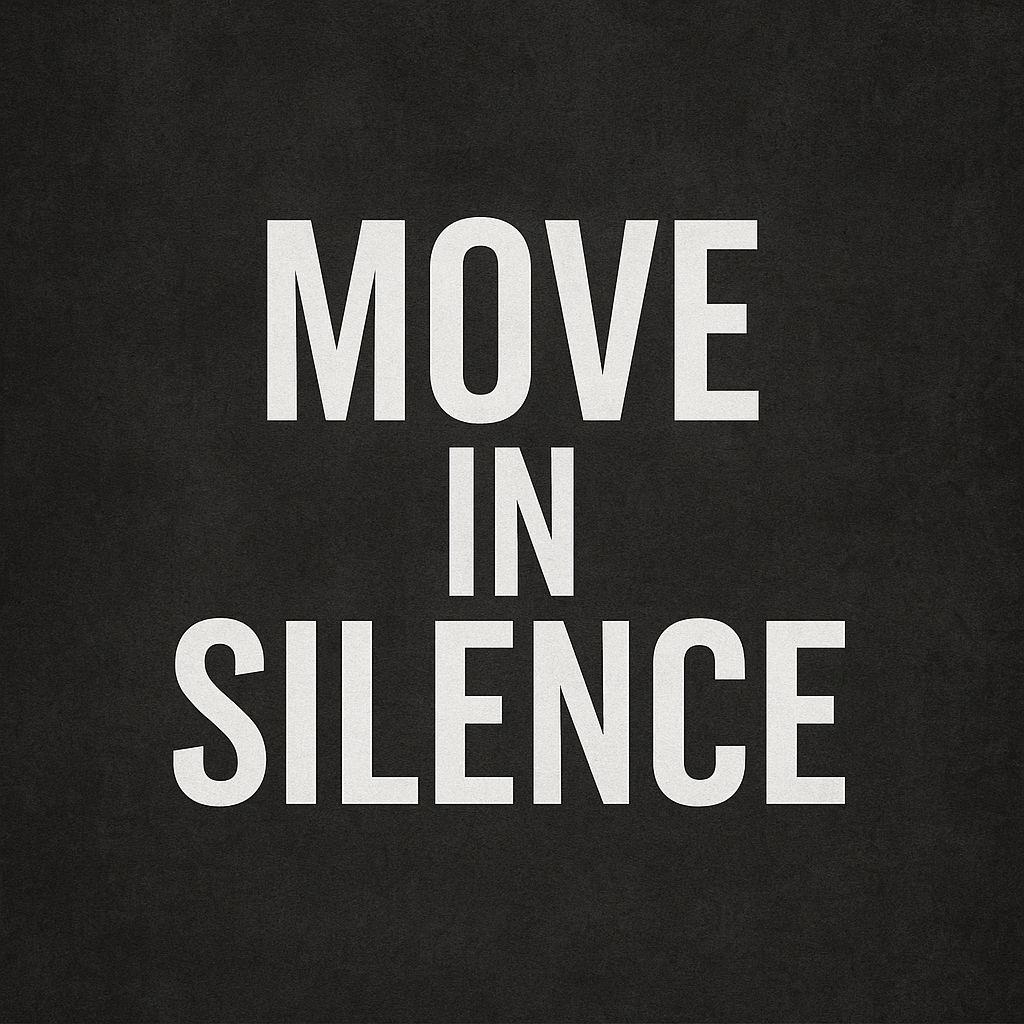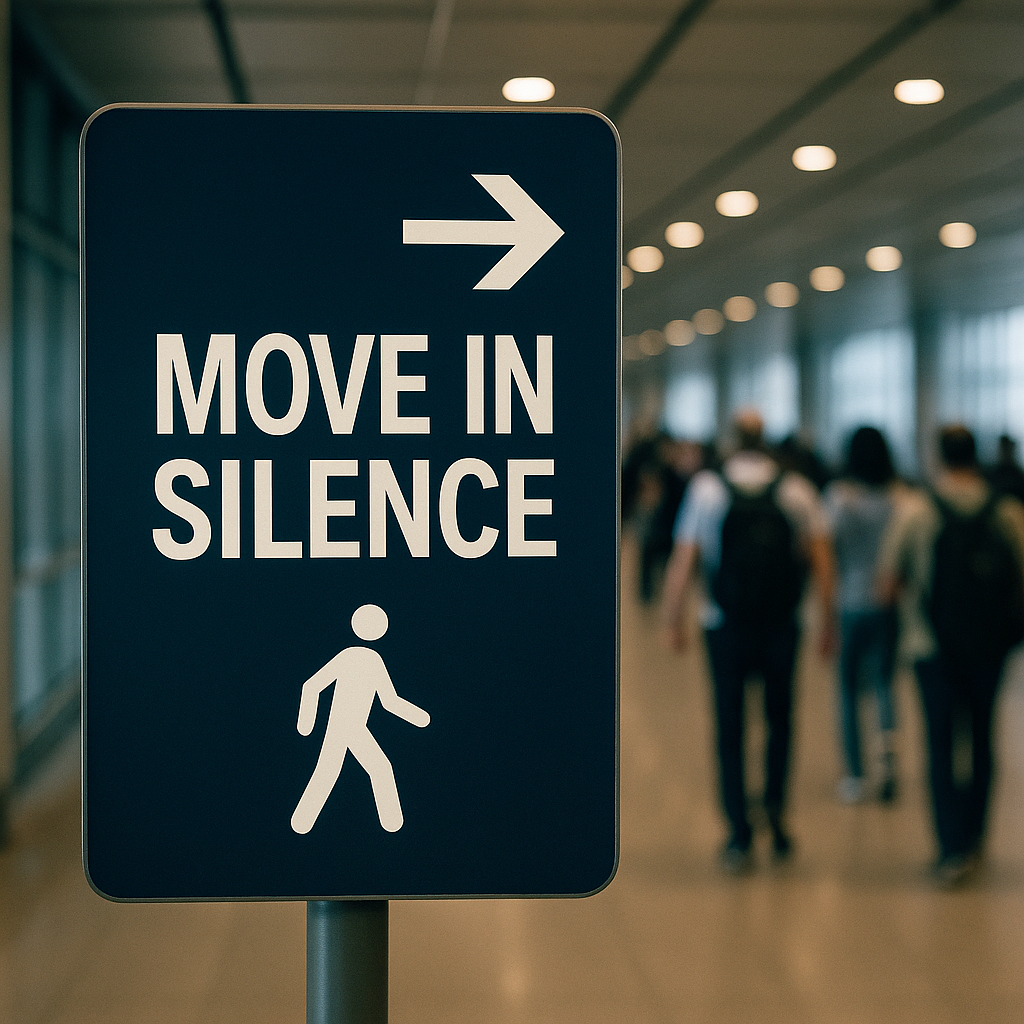| 최초 작성일 : 2025-08-24 | 수정일 : 2025-08-24 | 조회수 : 55 |

Prologue "Science confirms ‘Move in Silence’ trend might be the smartest way to achieve your goals" [Upworthy, July 5, 2025]. Recent scientific studies provide evidence for the viral online trend “Move in Silence,” showing that quietly pursuing goals is more effective than loudly declaring them. ------------------------------- In recent months, a short phrase has been circulating widely across social media platforms: “Move in Silence.” At first glance, it seems like yet another self-help slogan or internet meme. Yet its resonance has been striking. From TikTok clips to motivational threads on Twitter and Instagram reels, young people across the world have embraced the idea that one should achieve quietly rather than proclaim loudly. What makes this phrase particularly intriguing is that scientific research now supports its wisdom. According to studies highlighted by Upworthy, the more people announce their goals publicly, the less likely they are to follow through. Conversely, those who quietly work on their ambitions without broadcasting them tend to achieve higher levels of success. Why does this paradox occur? Researchers explain that the brain, upon declaring a goal, experiences a premature sense of accomplishment. When someone says, “I will run a marathon this year,” their brain often responds as if part of the achievement has already been secured, reducing the motivation to take action. Words, in this sense, can consume the psychological energy needed for execution. This is not just a trivial quirk of behavior—it points to something much deeper about human psychology and society. In an age where self-promotion is constant, and social media rewards visibility, the idea of remaining silent runs counter to dominant cultural values. Yet, silence seems to offer a stronger foundation for sustained achievement. This article aims to explore why. We will draw upon key academic theories—Self-Completion Theory, Self-Regulation Theory, Intrinsic Motivation Theory, the notion of Psychological Energy Dispersion, and Anthony Giddens’ concept of Life Politics—to explain why “Move in Silence” is more than an internet fad. These frameworks will help us understand the science behind the trend and reveal how it can reshape not only personal strategies but also organizational practices and cultural norms.
Why is it that loudly announcing one’s goals often undermines their achievement, while quiet action tends to bring greater success? To answer this, we turn to several influential theories in psychology and sociology. Together, they provide a multi-dimensional explanation for the wisdom embedded in the phrase “Move in Silence.” 1. Self-Completion Theory The first and perhaps most direct theoretical anchor is Self-Completion Theory, introduced by social psychologist Roy Baumeister and colleagues. This theory argues that individuals seek to “complete” their sense of identity by engaging in symbolic acts. When someone publicly declares a goal, such as “I will lose 10 kilograms” or “I will publish a book this year,” their brain interprets the announcement as a partial fulfillment of the goal. The social acknowledgment and praise that follow act as a substitute for real achievement. The danger is that the brain’s reward system is prematurely activated: dopamine is released, generating feelings of accomplishment that reduce the urgency to engage in sustained action. In other words, words trick the mind into believing progress has been made, even when no concrete steps have been taken. This theoretical lens makes it clear why silence is powerful. By withholding declarations, individuals prevent their brain from experiencing a false sense of closure, thus maintaining the motivational tension necessary to pursue actual tasks. 2. Self-Regulation Theory The second framework is Self-Regulation Theory, which highlights the finite nature of willpower. Every act of self-control consumes limited psychological resources, and effective goal pursuit depends on managing these resources carefully. Publicly declaring goals often drains self-regulation resources. Constantly explaining one’s intentions to others, responding to questions, and dealing with the social pressure of accountability all consume mental energy. These costs reduce the energy available for genuine, productive work. Conversely, maintaining silence conserves these limited resources. When individuals channel all available willpower into concrete actions rather than verbal declarations, they maximize the efficiency of their self-regulatory systems. In this sense, silence becomes a strategic conservation of energy, allowing greater focus and resilience in the face of obstacles. 3. Intrinsic Motivation Theory Richard Ryan and Edward Deci’s Self-Determination Theory divides motivation into two broad categories: extrinsic and intrinsic. Extrinsic motivation stems from rewards, recognition, or validation by others, while intrinsic motivation comes from genuine interest, personal values, or inner satisfaction. When individuals loudly announce their goals, they shift the motivational structure toward extrinsic rewards. They seek validation in the form of likes, comments, or social approval. The risk is that when this external feedback wanes, so too does the drive to act. In contrast, silence preserves intrinsic motivation. Quiet pursuit emphasizes “I am doing this for myself,” which aligns with long-term persistence and resilience. Intrinsic motivation thrives in silence, because it is not diluted by the constant need for external acknowledgment. 4. Psychological Energy Dispersion Beyond self-completion and motivation theories, research in cognitive psychology and neuroscience has documented the phenomenon of psychological energy dispersion. This refers to the way in which verbalizing intentions can deplete the very energy needed for execution. When people articulate their goals, their brain’s reward circuits simulate success. The release of neurotransmitters creates a fleeting sense of accomplishment, but this comes at a cost: diminished drive for real action. Simply put, talking about goals disperses psychological energy, leaving less available for the discipline and persistence required to achieve them. Empirical studies show that individuals who keep goals private are more likely to complete them than those who publicly declare them. This is not merely a matter of willpower but of neuropsychological efficiency. Silence prevents premature energy dispersion, ensuring that motivational resources remain intact until the goal is reached. 5. Life Politics – The Sociological Dimension Finally, we turn to Life Politics, a concept articulated by British sociologist Anthony Giddens. Giddens argues that in late modern societies, everyday choices—diet, exercise, fashion, consumption—are deeply political, reflecting broader cultural values and struggles over identity. Within this framework, “Move in Silence” is more than a personal productivity hack. It becomes a critique of contemporary culture’s obsession with visibility, performance, and self-promotion. In a society that demands constant updates, declarations, and demonstrations of productivity, choosing silence is an act of resistance. It asserts the right to pursue goals for one’s own reasons, without surrendering to the gaze of the crowd. Thus, “silent achievement” is not only efficient psychologically; it is also meaningful socially. It represents autonomy in an age of surveillance capitalism, where even personal goals risk becoming commodities for online attention. 6. Synthesis Taken together, these theories converge on a simple but profound insight: talking about goals is often counterproductive, while silence preserves the energy, motivation, and authenticity needed for success. Self-Completion Theory warns that declarations create premature satisfaction. Self-Regulation Theory emphasizes the conservation of limited willpower. Intrinsic Motivation Theory highlights the durability of inner drive over external validation. Psychological Energy Dispersion shows how words drain the neurological energy required for action. Life Politics situates silence as a cultural and political statement against performative society. In this light, “Move in Silence” is not a shallow meme but a distilled articulation of principles long recognized in psychology and sociology. Its popularity lies in its ability to condense these academic insights into a simple, memorable phrase that resonates with modern anxieties about distraction, exhaustion, and overexposure.
1. From Meme to Science The phrase “Move in Silence” began as a short, catchy meme circulating on TikTok, Instagram, and Twitter. Young people shared it as advice for productivity, self-discipline, and personal success. At first, it seemed like just another motivational slogan—something to be posted with inspirational background music or sleek typography. Yet the recent Upworthy article highlighted a striking twist: scientific studies validate the wisdom of this meme. Research shows that individuals who publicly declare their goals often underperform compared to those who remain quiet. Conversely, people who focus on silent execution tend to reach their targets more consistently. This transformation—from internet meme to scientifically grounded strategy—explains the widespread fascination. Memes thrive when they articulate experiences people already recognize. Almost everyone has felt the frustration of announcing a resolution (e.g., “I’ll work out every day this year”) only to abandon it weeks later. The meme captured this collective intuition, while research confirmed it as an empirical truth. 2. Self-Completion Theory: The Trap of Talking Self-Completion Theory provides a direct lens for interpreting the news. The Indian student’s viral video about vegetarian struggles in Korea showed how expressing identity relieves tension but reduces action. Similarly, announcing goals fulfills part of the psychological need without producing tangible progress. Take the example of a young professional who proclaims, “I will start my own business next year.” As soon as friends applaud and congratulate her, the brain registers a symbolic achievement. Dopamine is released, producing satisfaction. Yet no concrete step—market research, financial planning, or product development—has occurred. The Upworthy story illustrates this trap: speaking about goals creates the illusion of movement while actually delaying it. “Move in Silence” counters this illusion by encouraging individuals to withhold announcements and preserve motivational tension until action is complete. 3. Self-Regulation: Silence as Energy Conservation Theories of self-regulation explain why silence aids persistence. Every declaration of intent consumes mental resources: explaining, justifying, and responding to others’ questions drains energy. This is particularly true in digital contexts, where social media magnifies accountability. Posting a goal invites comments, skepticism, and scrutiny. The energy spent managing these reactions is energy lost to real work. Silence, by contrast, protects self-regulatory capacity. Individuals conserve their limited willpower by focusing inward rather than outward. As the article implies, “Move in Silence” functions as a psychological shield, allowing energy to be channeled directly into execution rather than dissipated in social performance. 4. Intrinsic Motivation: The Quiet Strength The news also connects to Self-Determination Theory. Public declarations shift motivation from intrinsic to extrinsic. A person who tweets about their new fitness routine may initially feel inspired, but their motivation soon hinges on likes, shares, or supportive comments. When feedback dwindles, motivation collapses. Those who remain silent avoid this trap. By pursuing goals privately, they cultivate intrinsic motivation: the satisfaction of working toward personal values rather than public validation. Silence thus nurtures authenticity, ensuring that achievements rest on inner drive rather than fleeting applause. 5. Psychological Energy Dispersion: Words Drain Power Cognitive neuroscience further clarifies the phenomenon. Declaring intentions activates the brain’s reward circuits prematurely, releasing dopamine that mimics the pleasure of accomplishment. The result is psychological energy dispersion—a subtle but measurable depletion of resources needed for persistence. The Upworthy article aligns perfectly with this research. Saying “I will accomplish X” disperses energy, while silently working toward X preserves it. The meme’s popularity stems from its intuitive resonance: people sense that talking wastes energy, while silence sharpens it. 6. Life Politics: A Cultural Counter-Narrative Beyond individual psychology, “Move in Silence” reflects broader sociological dynamics. Modern societies valorize visibility: to be recognized, one must declare, perform, and display. Social media epitomizes this logic, rewarding constant updates with likes and followers. Seen through Anthony Giddens’ concept of Life Politics, choosing silence is politically significant. It resists the pressure to commodify personal goals as content for online audiences. To move quietly is to reclaim autonomy, asserting that not all progress must be public or performative. In this sense, the Upworthy story is more than self-help—it signals a cultural counter-narrative. Silence is not weakness but resistance, a refusal to reduce life’s ambitions to spectacle. 7. The Korean Context – A Brief Note Although the news is global, its implications resonate strongly in contexts like South Korea, where collectivism and performance culture are pronounced. Public declarations of goals are common, from school settings to corporate life. Yet these practices may undermine effectiveness by creating premature satisfaction and social pressure. The principle of “Move in Silence” suggests that Korean society, like many others, could benefit from valuing execution over declaration. Just as excessive meat consumption threatens physical health, excessive verbalization threatens psychological stamina. Silence may therefore serve as both a cultural correction and a healthful strategy. 8. Synthesis The Upworthy article crystallizes the convergence of meme culture and academic theory. “Move in Silence” succeeds because it articulates a timeless truth in modern form: Talking can substitute for doing. Silence conserves energy, protects motivation, and reinforces authenticity. In a noisy world, silence itself becomes a radical act. By bridging meme culture, psychological research, and sociological critique, the article demonstrates how even viral internet trends can illuminate profound truths about human behavior and cultural values.

1. Individual Level – Write, Don’t Shout The first and most direct implication is personal. The research and meme alike teach that goals should be documented quietly rather than declared loudly. A person who posts their intentions on Instagram receives an instant dopamine hit, but this often substitutes for actual effort. Instead, individuals can adopt the practice of private journaling. Writing down small achievements builds a cumulative record of progress, reinforcing intrinsic motivation. Each checked box or completed note sustains momentum more effectively than applause from others. In practice: keep a silent log of daily or weekly progress. Let the results speak, not the announcements. 2. Organizational Level – From Slogan Culture to Execution Culture Corporations and institutions frequently rely on grand declarations: “Vision 2030,” “Innovation for All,” or “Revolutionizing the Market.” While such slogans inspire momentarily, they often fail to translate into tangible results. The principle of “Move in Silence” urges organizations to shift from performative declaration to practical execution. Replace flashy presentations with evidence of concrete results. Build reporting systems that highlight process improvements rather than lofty promises. Recognize and reward employees who quietly deliver outcomes, not just those who speak loudly about intentions. An execution-driven culture sustains long-term performance, while a slogan-driven culture risks becoming a hollow echo chamber. 3. Societal Level – Beyond the Age of Over-Communication Modern society is drowning in declarations. Social media encourages endless self-promotion, while professional cultures demand constant justification of one’s goals. This saturation of speech creates fatigue, distraction, and disillusionment. “Move in Silence” offers an antidote: a cultural norm that values quiet persistence over noisy performance. Imagine a society where success is recognized not by how loudly one promises but by how consistently one delivers. Such a shift could reduce social anxiety, restore trust, and foster healthier models of recognition. In this way, silence becomes a collective good, not just a personal tactic. 4. Educational Level – Teaching the Discipline of Quiet Progress Schools and universities often encourage students to declare ambitions: “Announce your dream,” “Share your resolution,” “Present your goals.” While well-intentioned, this practice may undermine persistence. Education should instead emphasize the discipline of silent progress. Teach students to track small, private achievements. Encourage portfolios of action rather than speeches of intent. Foster resilience by rewarding consistent behavior, not grand declarations. When young people learn to value execution over exhibition, they develop stronger self-regulation, greater autonomy, and healthier self-concepts. 5. Mental Health – Silence as a Stress-Reducer There is also a mental health dimension. Publicly declaring goals creates pressure: “I told everyone, but why haven’t I succeeded yet?” This breeds anxiety, guilt, and sometimes shame. By contrast, silent pursuit frees individuals from the burden of external judgment. The only accountability lies within, which reduces stress and fosters authentic satisfaction. Research shows that private progress is correlated with lower psychological distress and higher well-being. Thus, silence is not only a productivity tool but also a form of self-care. 6. Policy & Governance – Beyond Empty Promises Governments and institutions, too, often fall into the trap of over-declaration. Political leaders make bold promises—“eradicate poverty,” “revolutionize education,” “go green by 2050”—yet citizens frequently witness little change on the ground. The gap between speech and reality erodes trust. The lesson of “Move in Silence” applies here as well: less talk, more tangible execution. Implement small but visible pilot projects before announcing sweeping reforms. Let consistent results build credibility over time. Reframe leadership not as the art of speech-making but as the craft of silent, steady action. In governance, as in personal life, trust is earned not by words but by deeds. 7. Implications for South Korea and Beyond In South Korea, where collectivism and competitive culture heighten the pressure to constantly perform, the insights of “Move in Silence” carry special weight. Korean students, workers, and organizations often emphasize presentation over process, declaration over delivery. This cultural emphasis risks draining psychological resources and fueling burnout. Applying the principle of quiet execution could rebalance this tendency: Encourage students to document consistent efforts rather than announce lofty goals. Shift workplace recognition toward outcomes achieved quietly. Promote social norms that value perseverance and humility over boastful speech. By doing so, Korea—and other societies facing similar challenges—can cultivate healthier, more effective cultural practices. 8. Conclusion – Silence as a Universal Lesson The implications of “Move in Silence” extend across all levels of human life. For individuals: it conserves motivation. For organizations: it strengthens execution. For society: it challenges over-communication. For education: it teaches discipline. For mental health: it reduces stress. For governance: it restores trust. The overarching recommendation is clear: let silence do the work. By embracing the power of quiet action, people and institutions alike can achieve more, sustain progress longer, and foster cultures of authenticity rather than spectacle.
“Move in Silence.” Just four words, yet they encapsulate a wisdom that stretches across psychology, sociology, and even philosophy. What began as a viral internet meme has unfolded into a profound reflection on how humans pursue goals, conserve energy, and resist the pressures of a hyper-communicative society. At the heart of this idea lies a paradox: silence, often mistaken for weakness, is in fact a source of strength. Talking can give the illusion of progress, but it rarely produces results. True advancement happens in the quiet spaces—early mornings spent studying, late nights dedicated to work, consistent actions unobserved by the crowd. Silence is not the absence of action; it is the condition for authentic action. This truth resonates deeply in our era of overexposure. In a world where every meal is photographed, every achievement broadcast, and every intention shared online, silence feels almost radical. To refrain from announcing, to resist the urge to perform, is to reclaim autonomy over one’s own life. Silence says: “I am not doing this for applause. I am doing this because it matters to me.” There is also a timelessness to the message. Ancient wisdom traditions—from the Taoist emphasis on effortless action to the Buddhist practice of mindful silence—have long celebrated restraint and inner focus. What science has recently confirmed, philosophy has always known: strength grows in stillness. The implications for our daily lives are simple yet profound. If you want to write a book, do not tell everyone—just write. If you want to change your career, stop broadcasting your intentions—start building skills quietly. If you want to transform your health, resist the temptation to announce your diet—focus on what you eat today. The fewer words you spend, the more energy remains for action. The Upworthy article that sparked this discussion reminds us that even memes can serve as vessels of deep truth. “Move in Silence” is not just an online slogan; it is a practical, evidence-backed, life-shaping principle. It teaches us to guard our energy, to respect our goals enough not to waste them on talk, and to embrace the power of restraint. In the end, silence is not emptiness—it is potential. Within silence lies the possibility of transformation, the steady accumulation of progress, the quiet building of strength. When the time comes, silence will give way to results that speak louder than any promise ever could. So let this be the final word: true success does not announce itself. It grows quietly, until one day it cannot be ignored.














